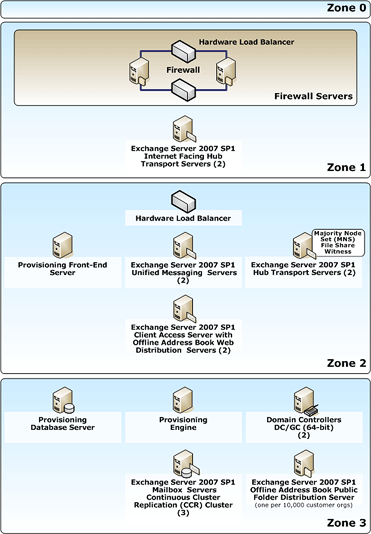The Entry Tier architecture is designed to support
between 5,000 and 20,000 active MAPI mailbox users. It includes
both dedicated servers and servers running more than one role:
- Two servers running Client Access roles, also using the CAS
servers as the web-based OAB distribution servers
- Two servers running Unified Messaging server roles
- Two servers running Hub Transport services
- Two external internet facing Hub Transport services
- Three cluster continuous replication (CCR) clusters (a total of
six physical servers)
 Note: Note: |
| Customers looking for a lower-TCO, lower-SLA solution could run
three local continuous replication (LCR) servers instead. |
- Two Active Directory Service Domain Controllers
- One Public Folder OAB server for every 10,000 hosted
organizations (for how to increase the maximum number of OABs on an
OAB server to 10,000, see KB
article945629.)
 Note: Note: |
| From manageability point view, Microsoft Hosted Messaging and
Collaboration version 4.5 deployments now suggest the separation of
the Client Access server from Unified Messaging server
roles. If Unified Messaging service is provided, from
scalability point view, it is OK to combine it with Client Access
server. However, service providers should take additional
consideration for the combination deployment. |
 Note: Note: |
| Actual MAPI users supported by the system could be
significantly higher, depending on the level of concurrency. For
example, if in average, 10% concurrent MAPI users are active, the
actual Entry Tire architecture can support up to two hundred
thousand MAPI users (200,000*10% = 20,000). |
 Note: Note: |
| Scalability is largely dependent on the protocol mix (for
example, the percentage of Outlook Anywhere, Outlook Web Access,
POP, IMAP) and the user’s usage profile. The recommendation is
based on heavy usage profile. |
The following figure shows the architecture for an
Entry Tier deployment.

 Note:
Note: Note:
Note: Note:
Note: Note:
Note: